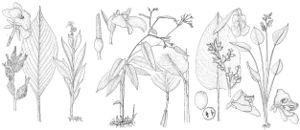Difference between revisions of "Canna flaccida"
Icones Stirpium Rariorum 3, plate 2. 1791.
FNA>Volume Importer |
FNA>Volume Importer |
(No difference)
| |
Revision as of 19:02, 24 September 2019
Rhizomes fleshy. Leaves: sheath and blade glaucous; blade narrowly ovate to narrowly elliptic, 20–50 × 8–12 cm, base gradually narrowed into sheath, apex acute. Inflorescences racemes, simple, bearing 1-flowered cincinni, fewer than 5 flowers per inflorescence; primary bracts 10–30 cm; secondary bracts generally absent; floral bracts persistent, (broadly) ovate-triangular, 0.5–1 × 0.4–0.7 cm, glaucous, apex entire or irregularly lobed; bracteoles ovate-triangular, 0.3–2 cm × 4–8 mm, apex entire or irregularly lobed. Flowers pure yellow, 10–15 cm; pedicels short, to 0.5 cm; sepals narrowly oblong-elliptic, 2.5–3.5 × 0.4–0.6 cm; petals strongly reflexed, 10–12 cm, tube ca. 4 cm, lobes narrowly oblong-elliptic, 6–8 cm × 4–13 mm, base sharply reflexed; staminodes 3, broadly ovate, 9–11 × 8–9 cm; labellum not obviously reflexed, broadly ovate, ca. 10 × 8–9 cm. Capsules irregularly ellipsoid, 5–6 × 4–4.5 cm. Seeds brown, nearly globose, 6–6.5 × 5–6 mm. 2n = 18.
Phenology: Flowering primarily summer; fruiting shortly thereafter.
Habitat: Seasonally wet areas in open marshes, lake margins, and inundated pine flatwoods
Elevation: 0–100 m
Distribution

Ala., Fla., Ga., La., S.C.
Discussion
Canna flaccida was reported from Texas (D. S. Correll and M. C. Johnston 1970), but no specimens have been seen to verify. Although no specimens have been seen from the area between the Louisiana site and the Alabama site, Canna flaccida is to be expected there.
Selected References
None.
